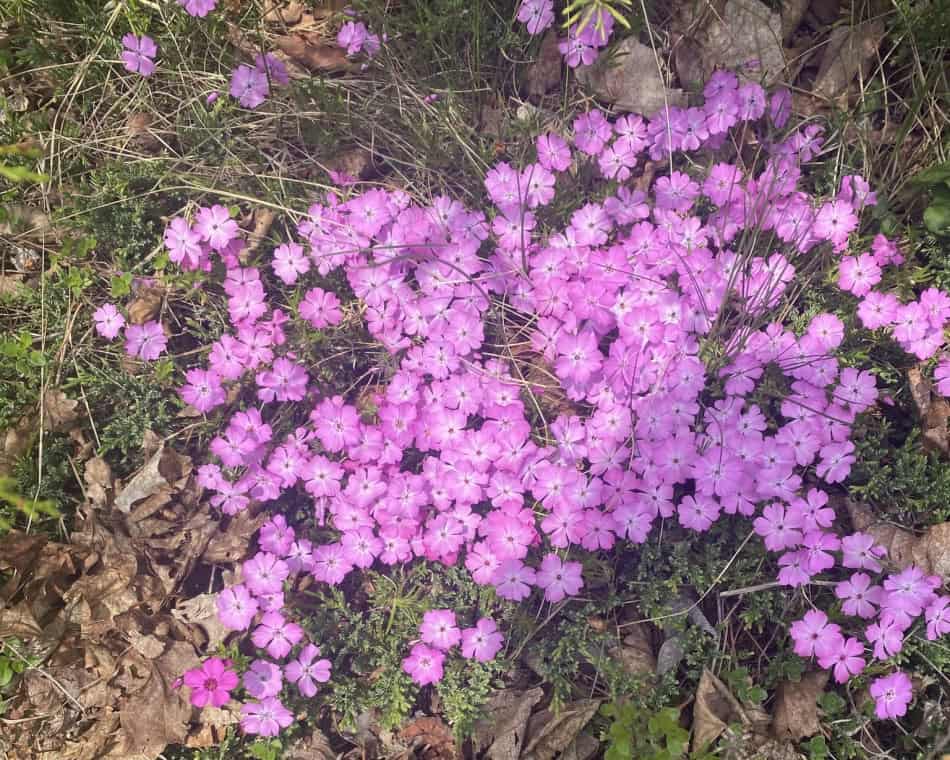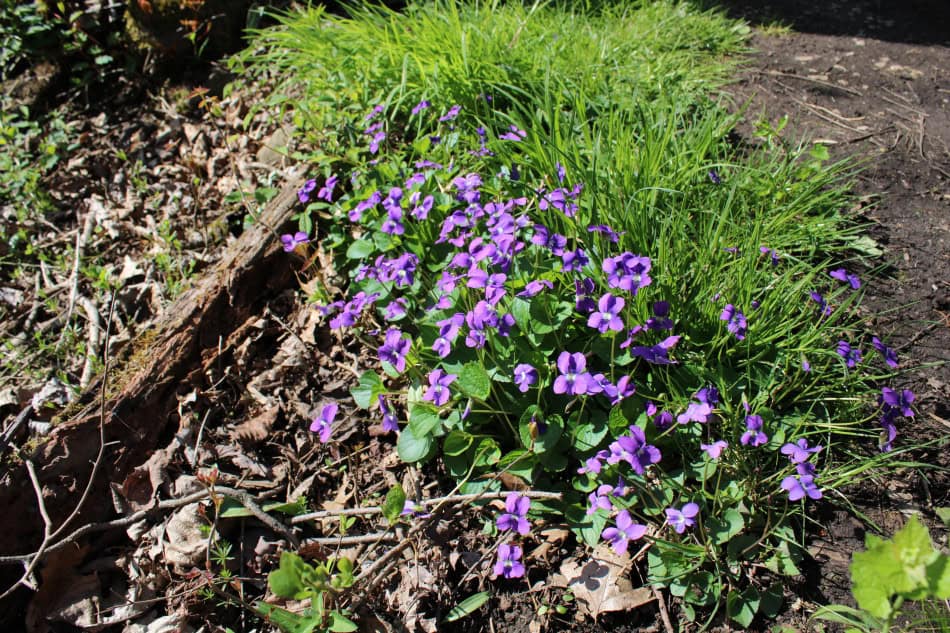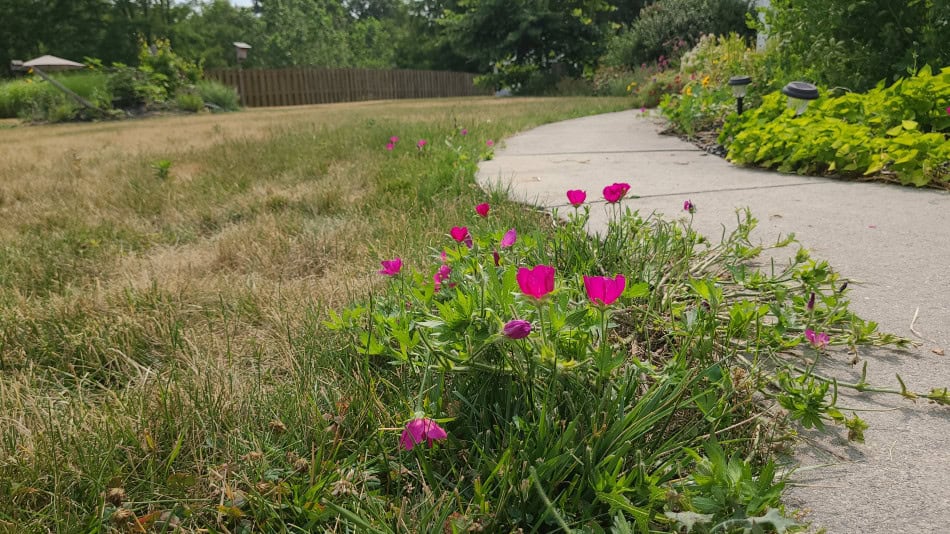Looking to add some ecological value to your lawn? Well, in this article I’ve compiled some natives that can survive moderate foot traffic as well as mowing. Many of these will bloom, providing a source of pollen and/or nectar to pollinators as well as break up the boring monoculture that is turfgrass. I’ll put some notes as well as my own observations as I have had or do have all of these growing in my own lawn in Pennsylvania! It’s nice to know that there are native flowers that can survive mowing in your lawn besides the invasive dandelions, yellow sorrel, or white clover. By growing, or letting some of these grow (because they often find their way there), you can help your local ecosystem in other ways as some of these are in fact host plants.
Now I’m not suggesting you replace your lawn with these, as I don’t think that would work (at least on it’s own). But these are just native flowers that can survive being mowed. Most will grow interspersed throughout the grass depending on the conditions. Just a couple points to remember, for these to work you will need to have your mower set to it’s maximum height (for typical push mowers). One other note, while they can all grow in your lawn, not all can survive heavy foot traffic. The best would be Yarrow, Sorrel, and Violets based on my experience.
Creeping Phlox (Phlox subulata)

Creeping Phlox is a spring bloomer native to the Mid-Atlantic and Northeastern United States/Canada, but established in much of the country. It is short – growing only 6″ tall and generally is clump-forming upwards of 2′ wide.
Also known as moss phlox, it likes to grow in shallow sandy/gravelly soils in full sun & well-draining soil. Now, even though it is clump forming individual turfgrass plants can grow interspersed among the blooms. And these blooms will attract bees, butterflies, and skippers. This plant is readily available from nurseries – even big-box stores.
Lawnflower (Calyptocarpus vialis)

Scientifically known as Calyptocarpus vialis, Lawnflower is a shade tolerant groundcover native to Texas and the gulf coast (it’s not well-suited for sun). Surviving moderate foot traffic, it grows upwards of 6-12″ tall in sun to shade. This will turn into a ground cover and crowd out grass, so be aware of that before planting it. But it will survive mowing, and can feed some pollinators along the way.
Smaller butterflies will visit (skippers mostly). But know that it is suited for the south, as it will go dormant in winter, which can be unsightly in a lawn. If you don’t mind this, then by all means.
Purslane Speedwell

Purslane Speedwell is a short, 3-12″ long annual wildflower that grows well in full sun to part shade and likes moist conditions. This is an annual, so needs to self-seed to continue/maintain it’s population.
The tiny white flowers of this are visited by short-tongue bees and pollinating flies. Charles Robertson recorded 13 species in his 1929 study.
Self Heal (Prunella vulgaris)

A short-perennial, Self-Heal is native to North America from Canada to Mexico. But this low-growing wildflower prefers full to part-sun and moist to medium moist soils. It blooms beautiful two-lipped flowers on round spiked flowerheads. It will bloom for about a month in Spring to Summer. And these flowerheads attract numerous species of bees and smaller butterflies.
I have had this growing in my yard for many years, mostly on the areas that receive shade from about mid-day until dusk. This allows them to never, or rarely dry out that helps maintain the population. So, although the published growing conditions say it can take full sun, know that the plant is not drought-tolerant.
Sorrell (Oxalis sp.)

Sorrels are a common name for plants of the Oxalis genus, and there is at least one native Sorrell for each state/province of North America. For the purpose of this article though, I’m going to focus on Yellow Wood Sorrel, Oxalis stricta.
Most often considered weeds, these tiny little groundcovers expand by stolon and seed. They are short and can survive mowing, but will would grow upwards of 12″ (but most likely falling over). Frequently mistaken for clover, Sorrel flowers will attract Halictid bees (as well as some other pollinators). The seeds can be eaten by some birds too!
But, if you don’t mind having a weedy lawn, then consider adding some sorrel. Or, more than likely, just don’t poison the sorrel that eventually finds it’s way to your lawn!
Turkey Tangle Frogfruit (Phyla nodiflora)

Native to the Southern states of America (CA to FL/VA and Northern Mexico), Turkey Tangle Frogfruit (what a fun name!) is as short groundcover (3-6″ tall) that can grow in full sun to part-shade and well-draining soil. The only other constraint is that it doesn’t tolerate cold weather.
The more sun it receives, the more flowers it will produce. And those flowers will do a great job attracting bees and other pollinators from May to October.
Violets (Viola sp.)

This list could not be complete without Violets! In the east this is probably the most common native flower you’d see in the lawn. Liking a bit of shade, these can tolerate full sun as long as there is some moisture.
They spread via rhizomes and seeds (which are often spread via ants). And will slowly colonize a lawn if permitted to do so.
White Avens (Geum canadense)

This is a shorter wildflower native from the Rocky Mountains to the Atlantic Ocean, White Avens. Left unchecked, it will grow roughly 1-2′ tall in part shade and slightly moist to slightly dry conditions. I often find this plant growing in my lawn near the woods that provide shade in the afternoon. Now, with regular mowing this will not flower, but it is a host plant and some other insects will feed on it’s foliage.
This one needs a bit of height to bloom. So while it can survive in a lawn, it won’t provide any nectar unless it’s allowed to grow.
Winecups (Callirhoe involucrata)

A low-growing perennial, Winecups is native to Central North America. Growing about 6″ tall (if unmowed), this one can survive mowings that are at least 2-1/2″ tall. Scientifically known as Callirhoe involucrata, It’s pink flowers bloom for about a month in Summer. Preferring full sun, it can tolerate part-shade and drought. But the biggest requirement is that the soil should drain well. So, make sure this is on a slope, even a slight one. I have seen this die out in compacted soils, which is what most turf-grass lawns are!
I discovered this could survive the mower by accident when it escaped an adjacent flowerbed and into my lawn across a sidewalk. But that was several years ago, and as long as my push-mower is set to it’s maximum height it will grow in my lawn just fine and survive repeated cuts.
Yarrow

One of the most prolific flowers in the world, Yarrow has colonized nearly the entire world. But, don’t fret- this one (Achillea millefolium) is native from coast to coast!
Reaching 12″ if un-mowed, it can grow in shallow, sandy, or densely compacted soils. Preferring full sun but tolerable of part-shade, it is highly adaptable. This one doesn’t always bloom if mowed, but in times of drought, when your grass goes dormant, Yarrow will often continue to grow and eventually bloom, where it’s flowers can then feed pollinators.
Conclusion
So, after reading this you hopefully have some ideas of native flowers that can be grown right in your lawn. The success of the plants will heavily depend on the growing conditions, so make sure you are aware of the sunlight/moisture/drainage of the area you wish to add these plants. I have some that thrive in hot dry environments (Yarrow, Winecups) and others that do well in areas with afternoon shade (Self-heal, violets). But if you are going to keep a lawn, this is one way to add some ecological value rather than just have it be a monoculture of turf grass.
Find more native plants here
Recent Posts
Got a flat wheelbarrow tire? You've come to the right place. I've repaired them multiple times. Whether you rolled it over a nail or the tube just became a bit worn, you can fix it and I will show...
Downy Wood Mint is a perennial wildflower native to Eastern North America[1]. Scientifically known as Blephilia ciliata, it grows 12-30” tall in full sun and well-draining soil[2][3]. Blooming...
